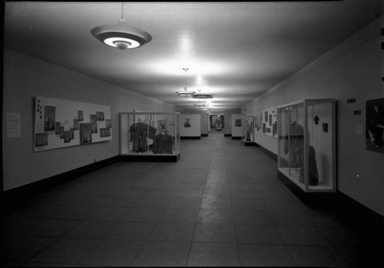
Exhibition of Enlarged Photos of Actors on the Classical Stage of Peiping by J. P. Dubosc
DATES January 23, 1938 through February 13, 1938
ORGANIZING DEPARTMENT
Asian Art
COLLECTIONS
Asian Art
-
January 20, 1938
On Friday, January 21, the Brooklyn Museum will open an Exhibition of Enlarged Photographs of Actors on the Classical Stage of Peiping recently taken by Mr. J. P. Dubosc of the French Legation. The exhibition will remain on view through February 6. Costumes and musical instruments relating to the theatre from the Museum’s own collection are also being shown at the same time.
Those photographs show the native Chinese theatre as it exists in Peiping still untouched by any Western touches, such as European stages, printed scenery and spotlights which in some other places have already considerably changed the ago—old Chinese theatrical forms.
The true Chinese play is a combination of spoken dialogue, operatic singing and ballet dancing. In the classical repertoire only those plays are given which are already hallowed by tradition. They are in a highly refined and perfected form in which every gesture is in a prescribed relation with the words and music. The audience already knows these plays by heart, and derives its pleasure from the performance rather than the plot. Good acting is applauded loudly, but the slightest deviation from the accepted routine is hissed.
Wind instruments, a mouth organ, trumpets, drums, bells and plucked string instruments make up the orchestra which accompanies every classical play.
The Chinese theatre itself is rather like that of the Elizabethan period in England, except that it is roofed. The stage also resembles the Elizabethan with lack of almost any scenery. There are only a few tables and chairs on it, and a large silk backdrop. The stage props are all conventional. Accordingly two uprights of bamboo with some calico attached represent a city wall. The property men, dressed in black, move the props about in full view of the audience, and even help the actors to change their costumes or give them tea out of the spout of the pot right on the stage.
The actors are all men, for women are not allowed on the classical stage, The men must impersonate the female roles,
declaiming in a falsetto voice and walking with a swaying, willow-like notion.
The gestures of the actors are ruled by as many conventions as the props. An actor lifts his foot to show he is stepping ever a threshold. An actor with whip in his left hand shows he is dismounting a horse or a mule; if the whip is in his right hand ho is mounting. Should an actor stand stiffly up against a pillar, he is hiding, or if he slowly moves his hand across his eyes he is crying.
The costumes are very gorgeous. The brightest silks are employed, and the whole effect is dazzling. These costumes generally are a rather fanciful version of fashion many hundreds of years old. The makeup too is very elaborate and there are many fantastic ways of painting the face.
The training of a Chinese actor is long and arduous. Young boys are sold or apprenticed to professional actors' schools, where they are trained for four years or longer. The course is very severe, and they are beaten if they make the slightest mistake. When considered competent, they are put on the stage and act without pay until their education is paid for. Then they receive a small salary, which if they are successful, is gradually increased to a large yearly income.
Brooklyn Museum Archives. Records of the Department of Public Information. Press releases, 1937 - 1939. 01-02_1938, 015-6.
View Original
